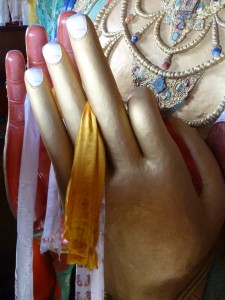Leh, Ladakh in the Indian Himalaya is as Buddhist as you can get. The ruler Sennge Namgyal did give the old town to the Muslims back in the 1600s when he married one of their girls, but Buddhism is the order of the day.
Of course, like most philosophies, Buddhist wisdom and has much to offer. To investigate this, I assumed the best place to start would be a monastery. There is no shortage of these in Leh and its surrounds. Hemis, Thiskey, Sankar, Stakna, Tsemo; they’re all there. Not only are they beautiful, but there are a lot of monks and Buddhist texts throughout. Small problem. They’re not in English.
Perhaps one of the many bookshops in Leh might hold the key. Plenty of books in English, but where do I start? The famine has turned into a gluttonous feast! Too hard.
I’ve done a lot of searching, but sometimes you just have to allow things to come to you. You know the scenario, when you stop looking, the answer will come up and bite you. So I guess it shouldn’t come as a surprise when, later that night, the only female drinking vodka in the only bar in Ladakh (how brazen of me!) with my new mate Kevin (not his real name), that my answer finds me.
It’s dark and almost closing time. There must be only about 10 fellow drinkers. All are locals but Kev and me. I want to know where all the other women are. A fellow drinker, dimmed by lack of lighting, informs me that females drinking alcohol is not looked on in a good light in India.
“But surely they can still come to a pub and drink soft drink!”, I argue.
Tabo the Buddhist sits opposite me. He’s older and of Mongolian decent. He’s had a few brews. “Where’s your wife?” I ask.
“At home. Asleep.”, he slurs back.
“Why isn’t she here?”, I push.
“She’s at home asleep”, is the reply. Tabo leans on his elbow, rests his chin in his hand and struggles to keep his eyes open. I realise that he’s not going to enlighten me as to the lack of females about. So, going all out, I ask Tabo the Buddhist a different question, “If you had just one snippet of wisdom to offer the world, Tabo, what would it be?”
Without contemplation he fires back his reply, “Vipassana.” The rest of the gathering laugh quietly at him, but he keeps repeating it over and over. “Vipassana, vipassana, vipassana”.
I look blankly. I have no idea what Tabo the Buddhist means. “Vipassana everyday. Everyone in the world. Everyone happy. No problems.”, he explains.
Buddhism holds Four Noble Truths.
- The truth of suffering
- The truth of the cause of suffering
- The truth of the end of suffering
- The truth of the path that frees us from suffering
Tabo the Buddhist was arguing that all of the four truths would be dealt with using vipassana. This type of meditation deals with looking at oneself. Translated it means ‘seeing clearly”. Deal with your own problems, so to speak rather than put the blame or responsibility on anyone else. It brings the energy back to the self instead of throwing it out all over the place. It re-establishes vertical energy flow rather than horizontal energy flow between each other. Understand attachments, realise they are unnecessary and become free of them. Buddhism is all about mindfulness and compassion and vipassana deals with the former.
Tabo the Buddhist believes that if every human starts their day with vipassana, everyone will contribute to the harmonious functioning of the world; pull their weight and do their bit and not be attached to others or things for happiness. It will dissolve the need to manipulate others or make them unhappy by attempting to inflict control over them
Although Tabo was under the weather a bit, rather unbuddhist if you think about it, he offers something to think about. It couldn’t hurt to give it a try. And surely Buddha’s “Middle Way” would allow the odd tin. Keeps things in perspective.


